technical specifications FORD F-250 2019 Owners Manual
[x] Cancel search | Manufacturer: FORD, Model Year: 2019, Model line: F-250, Model: FORD F-250 2019Pages: 666, PDF Size: 13.6 MB
Page 8 of 666
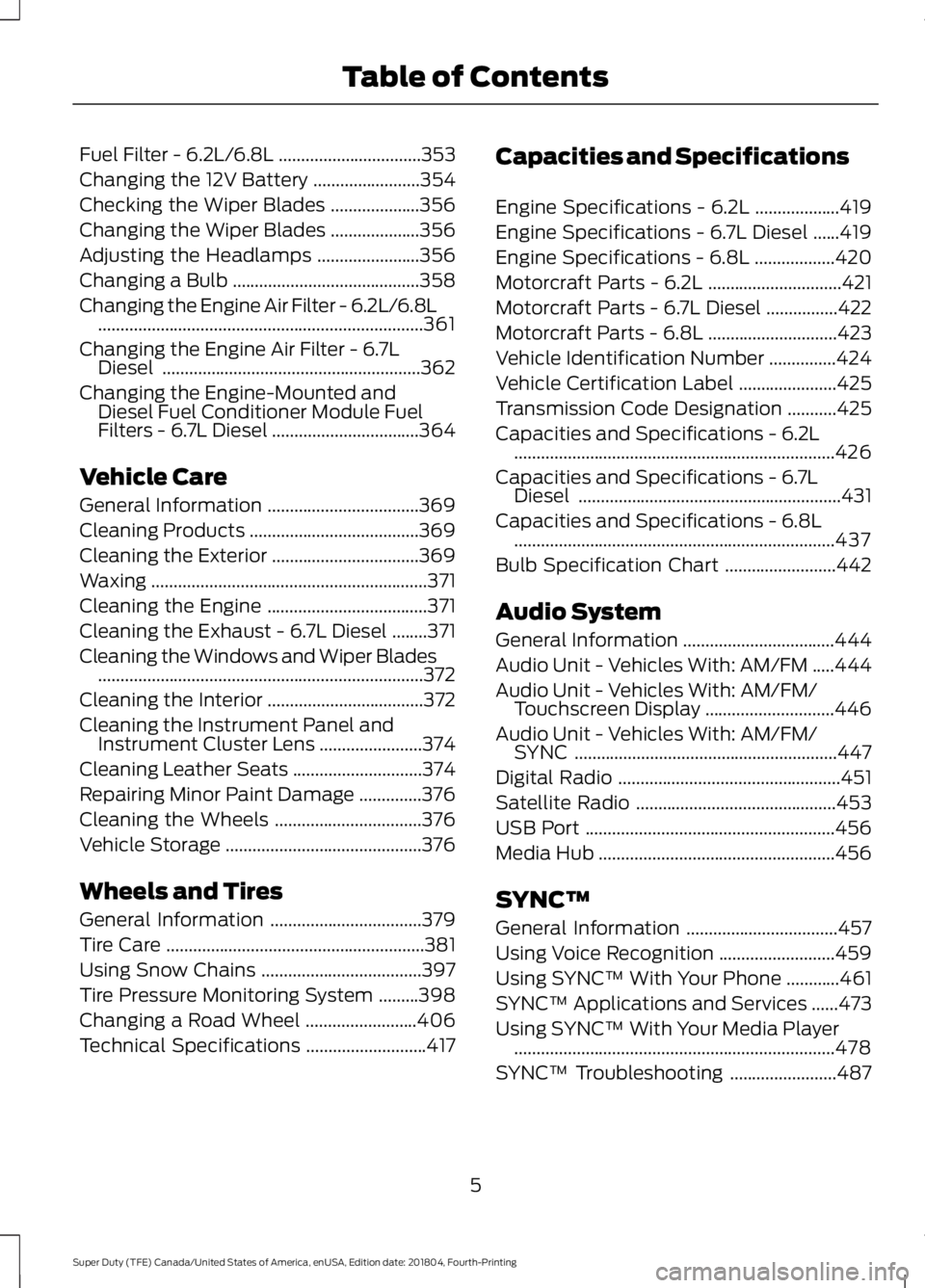
Fuel Filter - 6.2L/6.8L
................................353
Changing the 12V Battery ........................
354
Checking the Wiper Blades ....................
356
Changing the Wiper Blades ....................
356
Adjusting the Headlamps .......................
356
Changing a Bulb ..........................................
358
Changing the Engine Air Filter - 6.2L/6.8L ........................................................................\
.
361
Changing the Engine Air Filter - 6.7L Diesel ..........................................................
362
Changing the Engine-Mounted and Diesel Fuel Conditioner Module Fuel
Filters - 6.7L Diesel .................................
364
Vehicle Care
General Information ..................................
369
Cleaning Products ......................................
369
Cleaning the Exterior .................................
369
Waxing ..............................................................
371
Cleaning the Engine ....................................
371
Cleaning the Exhaust - 6.7L Diesel ........
371
Cleaning the Windows and Wiper Blades ........................................................................\
.
372
Cleaning the Interior ...................................
372
Cleaning the Instrument Panel and Instrument Cluster Lens .......................
374
Cleaning Leather Seats .............................
374
Repairing Minor Paint Damage ..............
376
Cleaning the Wheels .................................
376
Vehicle Storage ............................................
376
Wheels and Tires
General Information ..................................
379
Tire Care ..........................................................
381
Using Snow Chains ....................................
397
Tire Pressure Monitoring System .........
398
Changing a Road Wheel .........................
406
Technical Specifications ...........................
417Capacities and Specifications
Engine Specifications - 6.2L
...................
419
Engine Specifications - 6.7L Diesel ......
419
Engine Specifications - 6.8L ..................
420
Motorcraft Parts - 6.2L ..............................
421
Motorcraft Parts - 6.7L Diesel ................
422
Motorcraft Parts - 6.8L .............................
423
Vehicle Identification Number ...............
424
Vehicle Certification Label ......................
425
Transmission Code Designation ...........
425
Capacities and Specifications - 6.2L ........................................................................\
426
Capacities and Specifications - 6.7L Diesel ...........................................................
431
Capacities and Specifications - 6.8L ........................................................................\
437
Bulb Specification Chart .........................
442
Audio System
General Information ..................................
444
Audio Unit - Vehicles With: AM/FM .....
444
Audio Unit - Vehicles With: AM/FM/ Touchscreen Display .............................
446
Audio Unit - Vehicles With: AM/FM/ SYNC ...........................................................
447
Digital Radio ..................................................
451
Satellite Radio .............................................
453
USB Port ........................................................
456
Media Hub .....................................................
456
SYNC™
General Information ..................................
457
Using Voice Recognition ..........................
459
Using SYNC™ With Your Phone ............
461
SYNC™ Applications and Services ......
473
Using SYNC™ With Your Media Player ........................................................................\
478
SYNC™ Troubleshooting ........................
487
5
Super Duty (TFE) Canada/United States of America, enUSA, Edition date: 201804, Fourth-Printing Table of Contents
Page 61 of 666
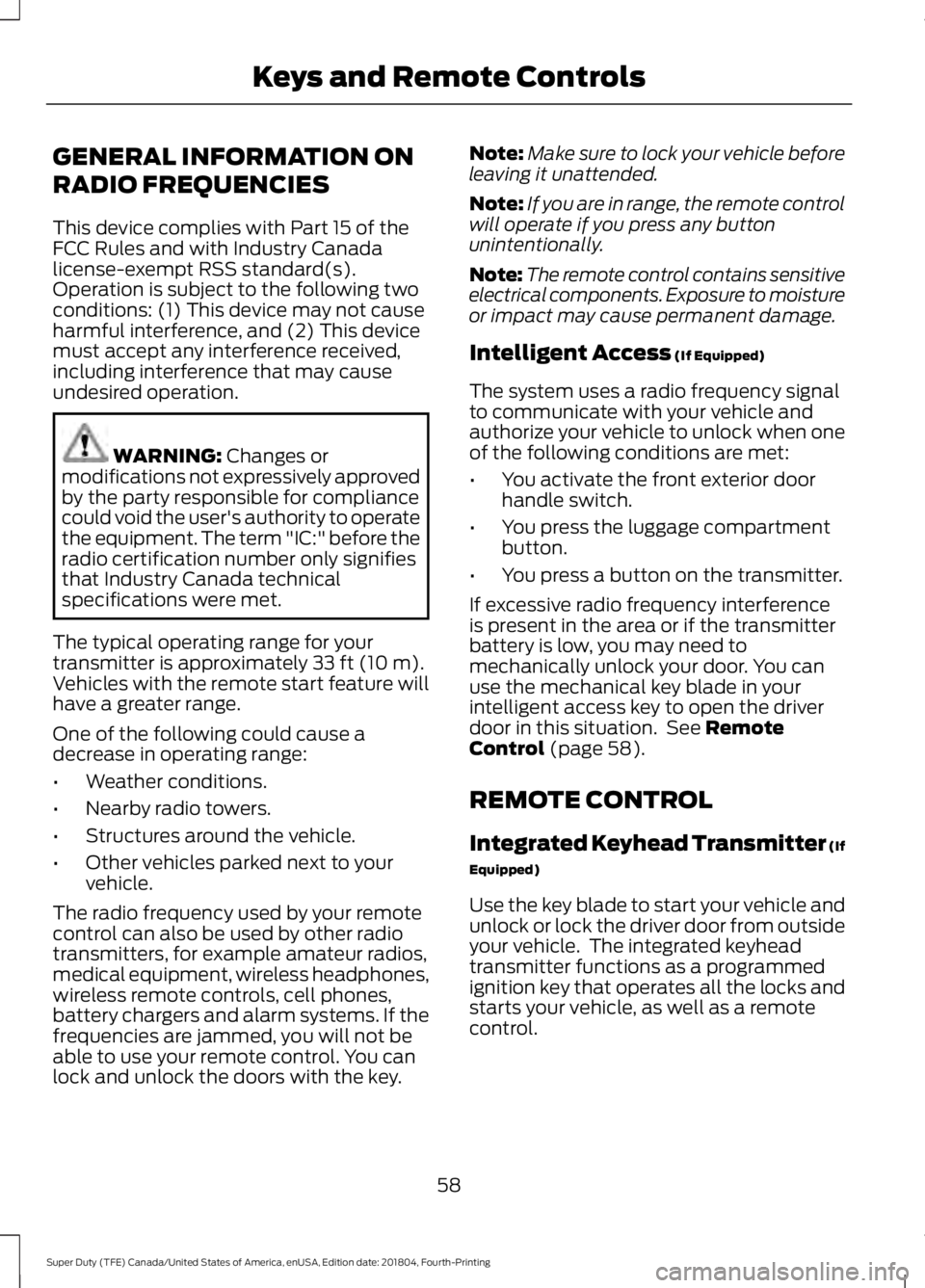
GENERAL INFORMATION ON
RADIO FREQUENCIES
This device complies with Part 15 of the
FCC Rules and with Industry Canada
license-exempt RSS standard(s).
Operation is subject to the following two
conditions: (1) This device may not cause
harmful interference, and (2) This device
must accept any interference received,
including interference that may cause
undesired operation.
WARNING: Changes or
modifications not expressively approved
by the party responsible for compliance
could void the user's authority to operate
the equipment. The term "IC:" before the
radio certification number only signifies
that Industry Canada technical
specifications were met.
The typical operating range for your
transmitter is approximately
33 ft (10 m).
Vehicles with the remote start feature will
have a greater range.
One of the following could cause a
decrease in operating range:
• Weather conditions.
• Nearby radio towers.
• Structures around the vehicle.
• Other vehicles parked next to your
vehicle.
The radio frequency used by your remote
control can also be used by other radio
transmitters, for example amateur radios,
medical equipment, wireless headphones,
wireless remote controls, cell phones,
battery chargers and alarm systems. If the
frequencies are jammed, you will not be
able to use your remote control. You can
lock and unlock the doors with the key. Note:
Make sure to lock your vehicle before
leaving it unattended.
Note: If you are in range, the remote control
will operate if you press any button
unintentionally.
Note: The remote control contains sensitive
electrical components. Exposure to moisture
or impact may cause permanent damage.
Intelligent Access
(If Equipped)
The system uses a radio frequency signal
to communicate with your vehicle and
authorize your vehicle to unlock when one
of the following conditions are met:
• You activate the front exterior door
handle switch.
• You press the luggage compartment
button.
• You press a button on the transmitter.
If excessive radio frequency interference
is present in the area or if the transmitter
battery is low, you may need to
mechanically unlock your door. You can
use the mechanical key blade in your
intelligent access key to open the driver
door in this situation. See
Remote
Control (page 58).
REMOTE CONTROL
Integrated Keyhead Transmitter (If
Equipped)
Use the key blade to start your vehicle and
unlock or lock the driver door from outside
your vehicle. The integrated keyhead
transmitter functions as a programmed
ignition key that operates all the locks and
starts your vehicle, as well as a remote
control.
58
Super Duty (TFE) Canada/United States of America, enUSA, Edition date: 201804, Fourth-Printing Keys and Remote Controls
Page 170 of 666
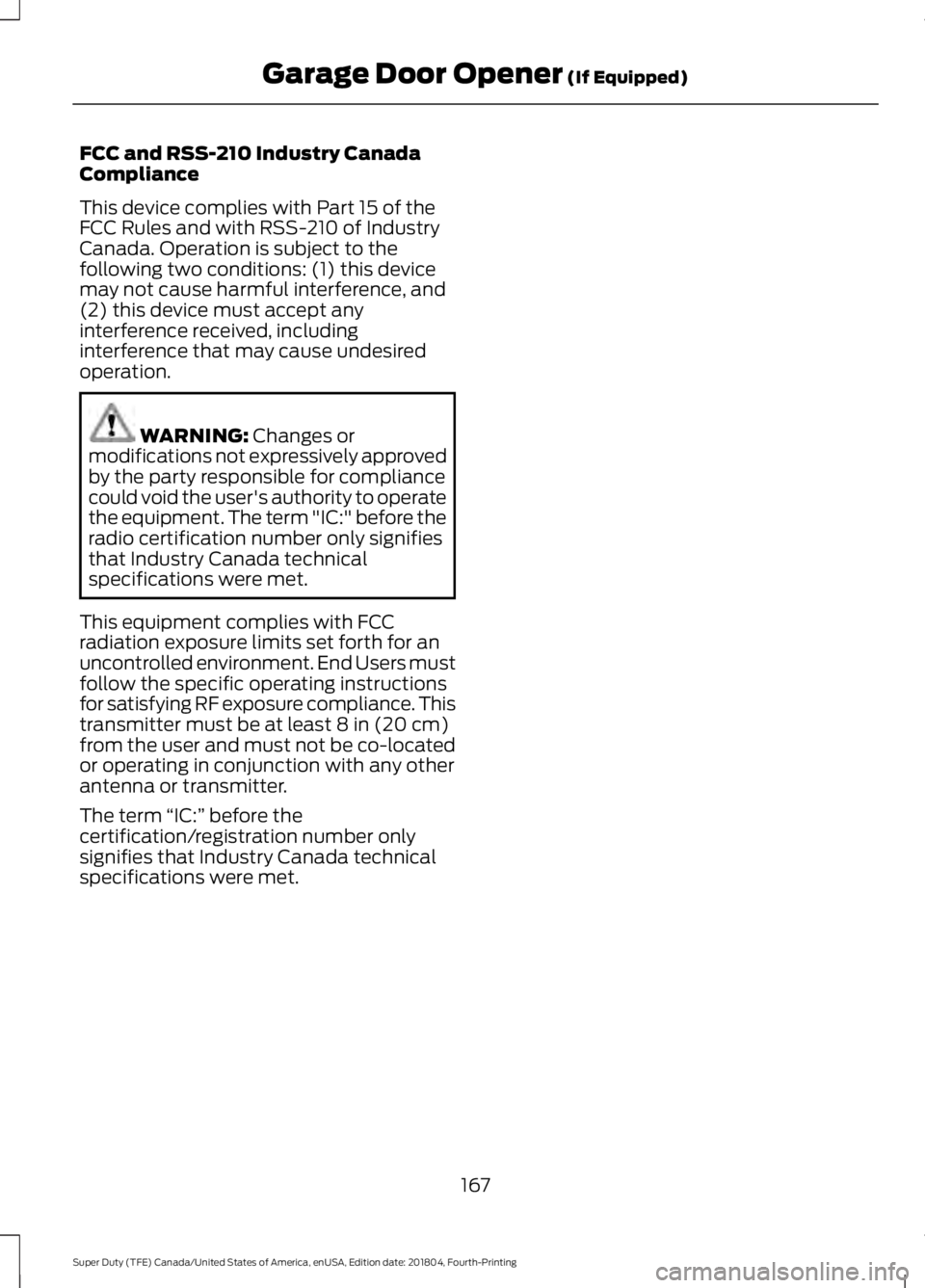
FCC and RSS-210 Industry Canada
Compliance
This device complies with Part 15 of the
FCC Rules and with RSS-210 of Industry
Canada. Operation is subject to the
following two conditions: (1) this device
may not cause harmful interference, and
(2) this device must accept any
interference received, including
interference that may cause undesired
operation.
WARNING: Changes or
modifications not expressively approved
by the party responsible for compliance
could void the user's authority to operate
the equipment. The term "IC:" before the
radio certification number only signifies
that Industry Canada technical
specifications were met.
This equipment complies with FCC
radiation exposure limits set forth for an
uncontrolled environment. End Users must
follow the specific operating instructions
for satisfying RF exposure compliance. This
transmitter must be at least
8 in (20 cm)
from the user and must not be co-located
or operating in conjunction with any other
antenna or transmitter.
The term “IC:” before the
certification/registration number only
signifies that Industry Canada technical
specifications were met.
167
Super Duty (TFE) Canada/United States of America, enUSA, Edition date: 201804, Fourth-Printing Garage Door Opener
(If Equipped)
Page 402 of 666
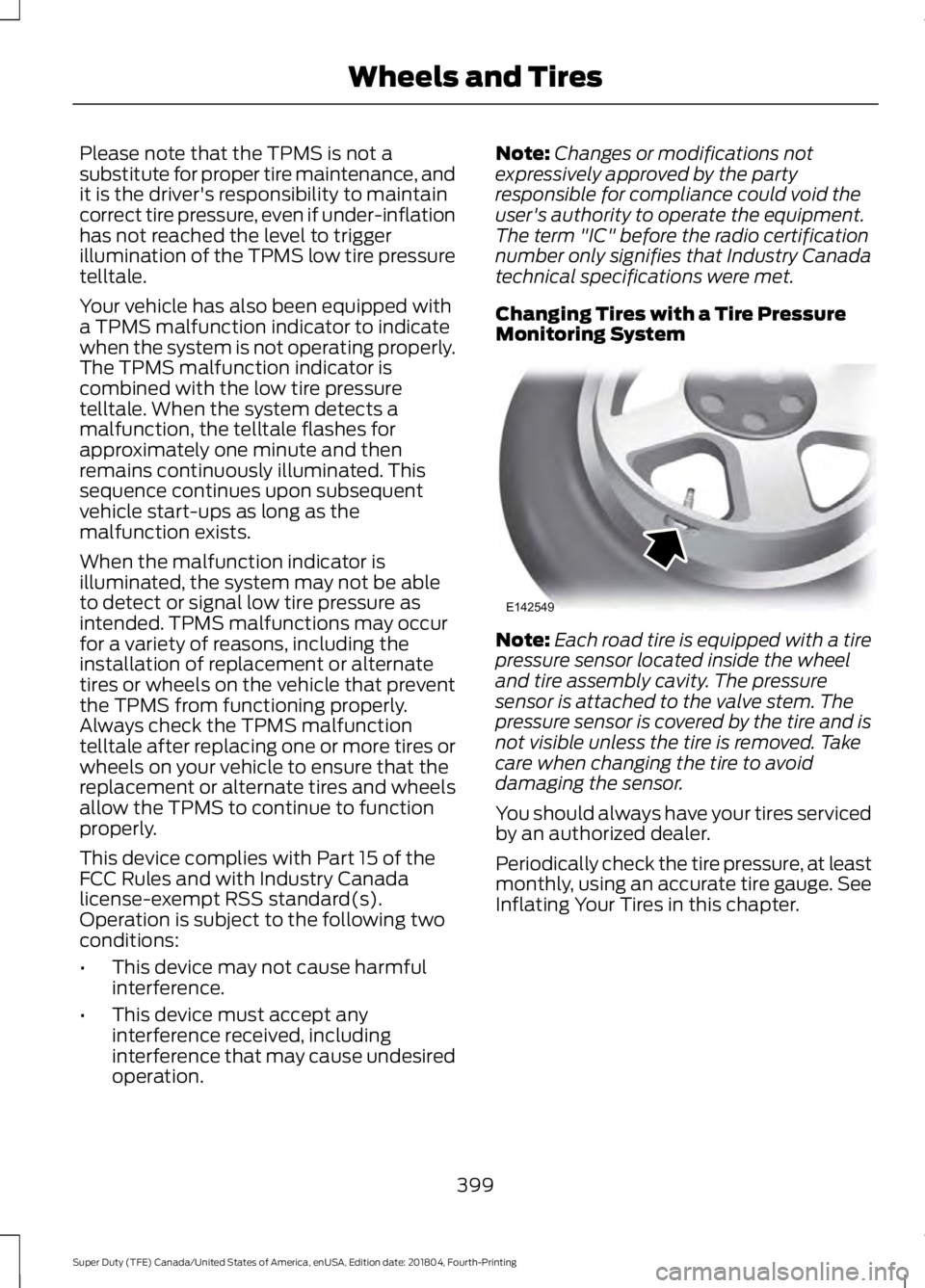
Please note that the TPMS is not a
substitute for proper tire maintenance, and
it is the driver's responsibility to maintain
correct tire pressure, even if under-inflation
has not reached the level to trigger
illumination of the TPMS low tire pressure
telltale.
Your vehicle has also been equipped with
a TPMS malfunction indicator to indicate
when the system is not operating properly.
The TPMS malfunction indicator is
combined with the low tire pressure
telltale. When the system detects a
malfunction, the telltale flashes for
approximately one minute and then
remains continuously illuminated. This
sequence continues upon subsequent
vehicle start-ups as long as the
malfunction exists.
When the malfunction indicator is
illuminated, the system may not be able
to detect or signal low tire pressure as
intended. TPMS malfunctions may occur
for a variety of reasons, including the
installation of replacement or alternate
tires or wheels on the vehicle that prevent
the TPMS from functioning properly.
Always check the TPMS malfunction
telltale after replacing one or more tires or
wheels on your vehicle to ensure that the
replacement or alternate tires and wheels
allow the TPMS to continue to function
properly.
This device complies with Part 15 of the
FCC Rules and with Industry Canada
license-exempt RSS standard(s).
Operation is subject to the following two
conditions:
•
This device may not cause harmful
interference.
• This device must accept any
interference received, including
interference that may cause undesired
operation. Note:
Changes or modifications not
expressively approved by the party
responsible for compliance could void the
user's authority to operate the equipment.
The term "IC" before the radio certification
number only signifies that Industry Canada
technical specifications were met.
Changing Tires with a Tire Pressure
Monitoring System Note:
Each road tire is equipped with a tire
pressure sensor located inside the wheel
and tire assembly cavity. The pressure
sensor is attached to the valve stem. The
pressure sensor is covered by the tire and is
not visible unless the tire is removed. Take
care when changing the tire to avoid
damaging the sensor.
You should always have your tires serviced
by an authorized dealer.
Periodically check the tire pressure, at least
monthly, using an accurate tire gauge. See
Inflating Your Tires in this chapter.
399
Super Duty (TFE) Canada/United States of America, enUSA, Edition date: 201804, Fourth-Printing Wheels and TiresE142549
Page 414 of 666
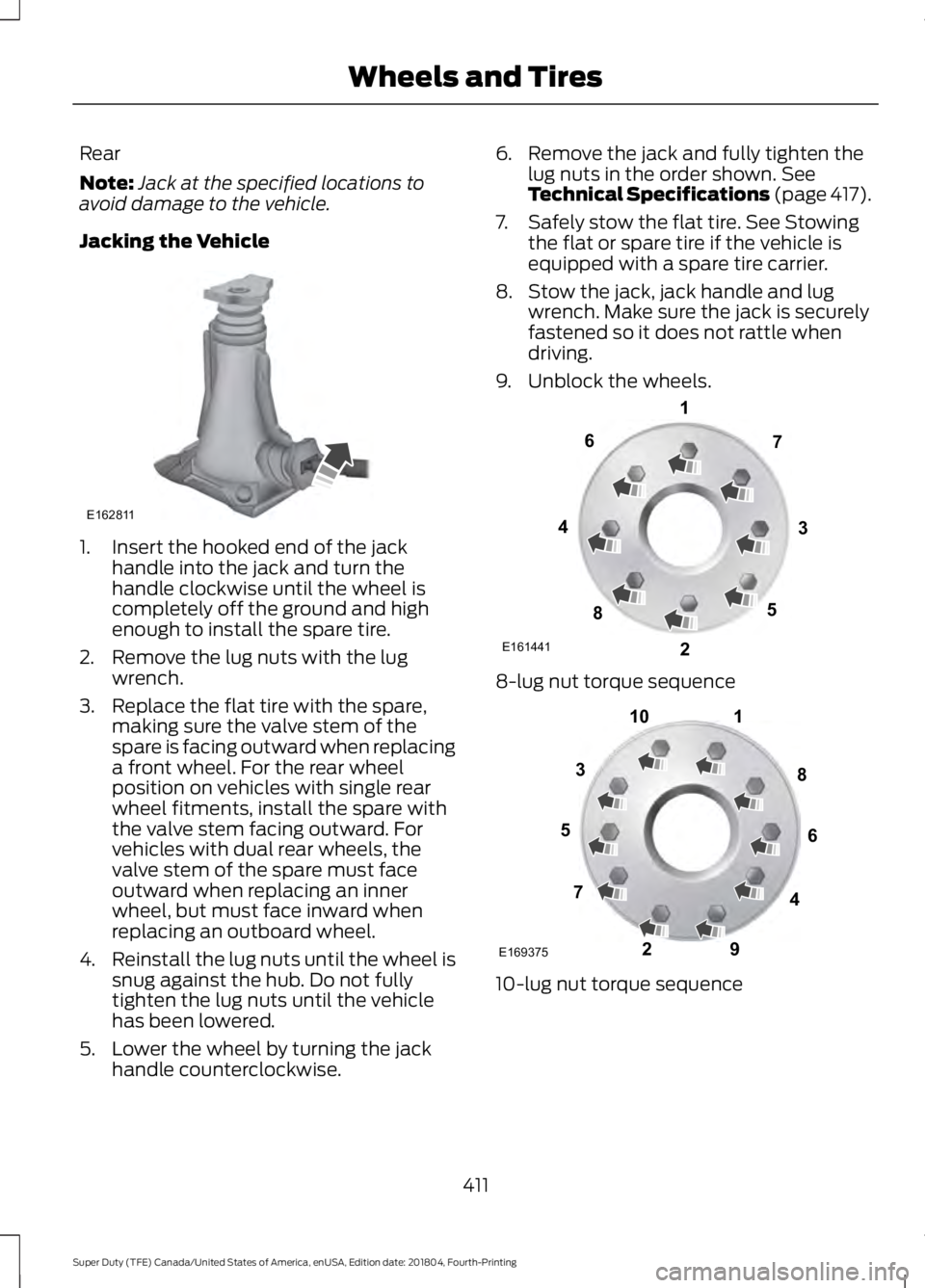
Rear
Note:
Jack at the specified locations to
avoid damage to the vehicle.
Jacking the Vehicle 1. Insert the hooked end of the jack
handle into the jack and turn the
handle clockwise until the wheel is
completely off the ground and high
enough to install the spare tire.
2. Remove the lug nuts with the lug wrench.
3. Replace the flat tire with the spare, making sure the valve stem of the
spare is facing outward when replacing
a front wheel. For the rear wheel
position on vehicles with single rear
wheel fitments, install the spare with
the valve stem facing outward. For
vehicles with dual rear wheels, the
valve stem of the spare must face
outward when replacing an inner
wheel, but must face inward when
replacing an outboard wheel.
4. Reinstall the lug nuts until the wheel is
snug against the hub. Do not fully
tighten the lug nuts until the vehicle
has been lowered.
5. Lower the wheel by turning the jack handle counterclockwise. 6. Remove the jack and fully tighten the
lug nuts in the order shown. See
Technical Specifications (page 417).
7. Safely stow the flat tire. See Stowing the flat or spare tire if the vehicle is
equipped with a spare tire carrier.
8. Stow the jack, jack handle and lug wrench. Make sure the jack is securely
fastened so it does not rattle when
driving.
9. Unblock the wheels. 8-lug nut torque sequence
10-lug nut torque sequence
411
Super Duty (TFE) Canada/United States of America, enUSA, Edition date: 201804, Fourth-Printing Wheels and TiresE162811 E161441
13
4
27
6
5
8 1
2
3
4
5
6
7 8
9
10
E169375
Page 417 of 666
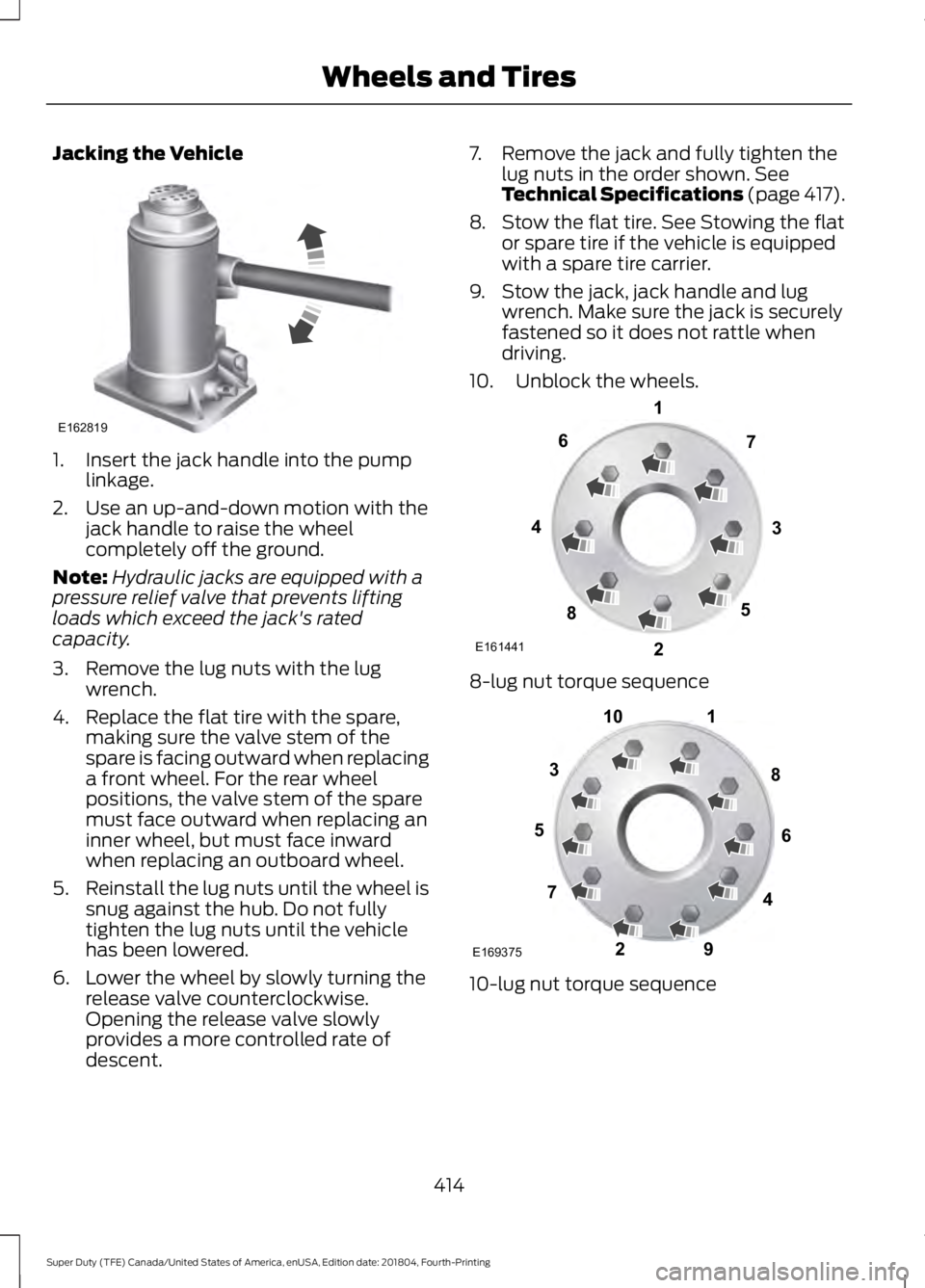
Jacking the Vehicle
1. Insert the jack handle into the pump
linkage.
2. Use an up-and-down motion with the jack handle to raise the wheel
completely off the ground.
Note: Hydraulic jacks are equipped with a
pressure relief valve that prevents lifting
loads which exceed the jack's rated
capacity.
3. Remove the lug nuts with the lug wrench.
4. Replace the flat tire with the spare, making sure the valve stem of the
spare is facing outward when replacing
a front wheel. For the rear wheel
positions, the valve stem of the spare
must face outward when replacing an
inner wheel, but must face inward
when replacing an outboard wheel.
5. Reinstall the lug nuts until the wheel is
snug against the hub. Do not fully
tighten the lug nuts until the vehicle
has been lowered.
6. Lower the wheel by slowly turning the release valve counterclockwise.
Opening the release valve slowly
provides a more controlled rate of
descent. 7. Remove the jack and fully tighten the
lug nuts in the order shown. See
Technical Specifications (page 417).
8. Stow the flat tire. See Stowing the flat or spare tire if the vehicle is equipped
with a spare tire carrier.
9. Stow the jack, jack handle and lug wrench. Make sure the jack is securely
fastened so it does not rattle when
driving.
10. Unblock the wheels. 8-lug nut torque sequence
10-lug nut torque sequence
414
Super Duty (TFE) Canada/United States of America, enUSA, Edition date: 201804, Fourth-Printing Wheels and TiresE162819 E161441
13
4
27
6
5
8 1
2
3
4
5
6
7 8
9
10
E169375
Page 420 of 666
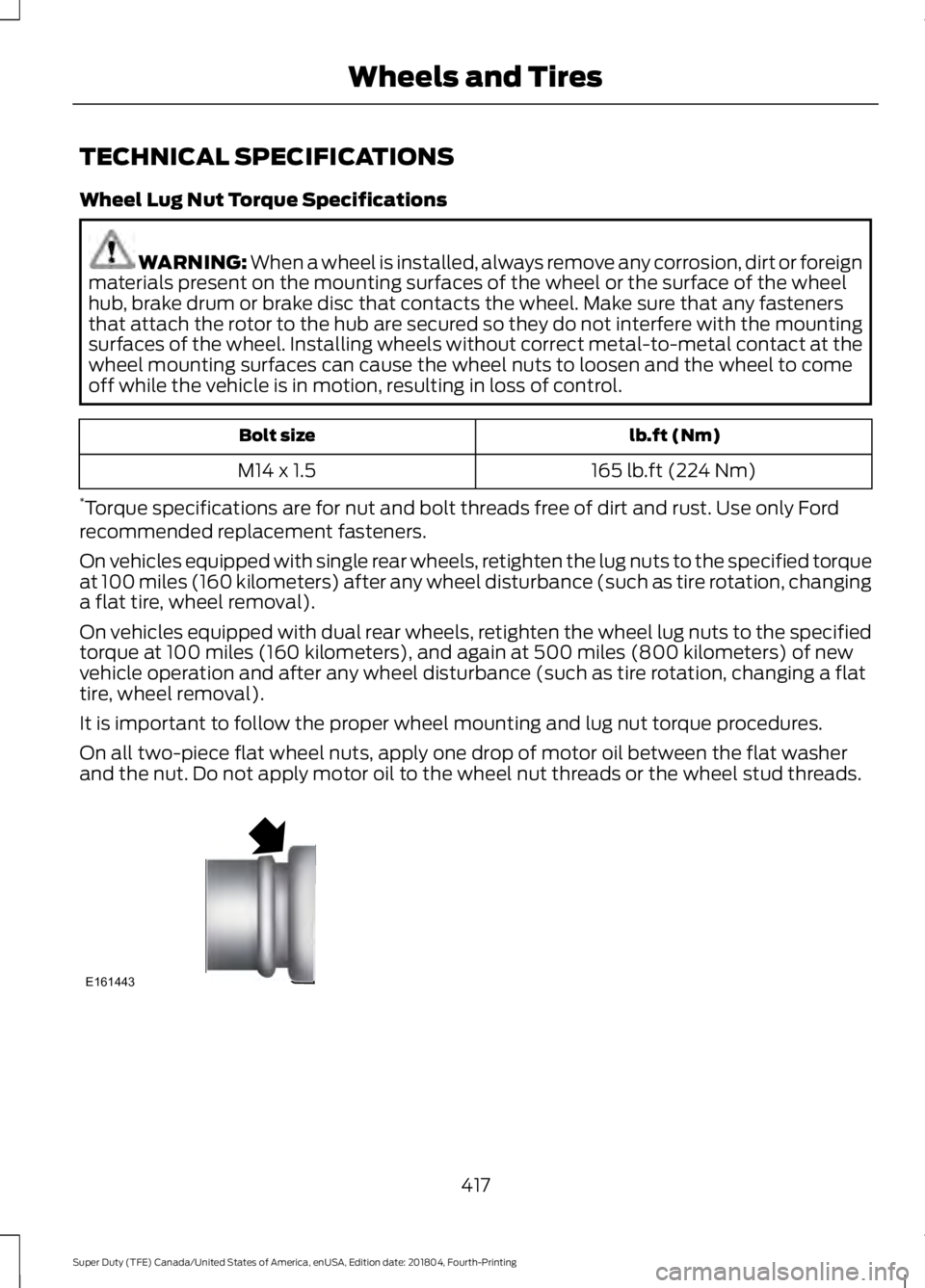
TECHNICAL SPECIFICATIONS
Wheel Lug Nut Torque Specifications
WARNING: When a wheel is installed, always remove any corrosion, dirt or foreign
materials present on the mounting surfaces of the wheel or the surface of the wheel
hub, brake drum or brake disc that contacts the wheel. Make sure that any fasteners
that attach the rotor to the hub are secured so they do not interfere with the mounting
surfaces of the wheel. Installing wheels without correct metal-to-metal contact at the
wheel mounting surfaces can cause the wheel nuts to loosen and the wheel to come
off while the vehicle is in motion, resulting in loss of control. lb.ft (Nm)
Bolt size
165 lb.ft (224 Nm)
M14 x 1.5
* Torque specifications are for nut and bolt threads free of dirt and rust. Use only Ford
recommended replacement fasteners.
On vehicles equipped with single rear wheels, retighten the lug nuts to the specified torque
at 100 miles (160 kilometers) after any wheel disturbance (such as tire rotation, changing
a flat tire, wheel removal).
On vehicles equipped with dual rear wheels, retighten the wheel lug nuts to the specified
torque at 100 miles (160 kilometers), and again at 500 miles (800 kilometers) of new
vehicle operation and after any wheel disturbance (such as tire rotation, changing a flat
tire, wheel removal).
It is important to follow the proper wheel mounting and lug nut torque procedures.
On all two-piece flat wheel nuts, apply one drop of motor oil between the flat washer
and the nut. Do not apply motor oil to the wheel nut threads or the wheel stud threads. 417
Super Duty (TFE) Canada/United States of America, enUSA, Edition date: 201804, Fourth-Printing Wheels and TiresE161443
Page 637 of 666
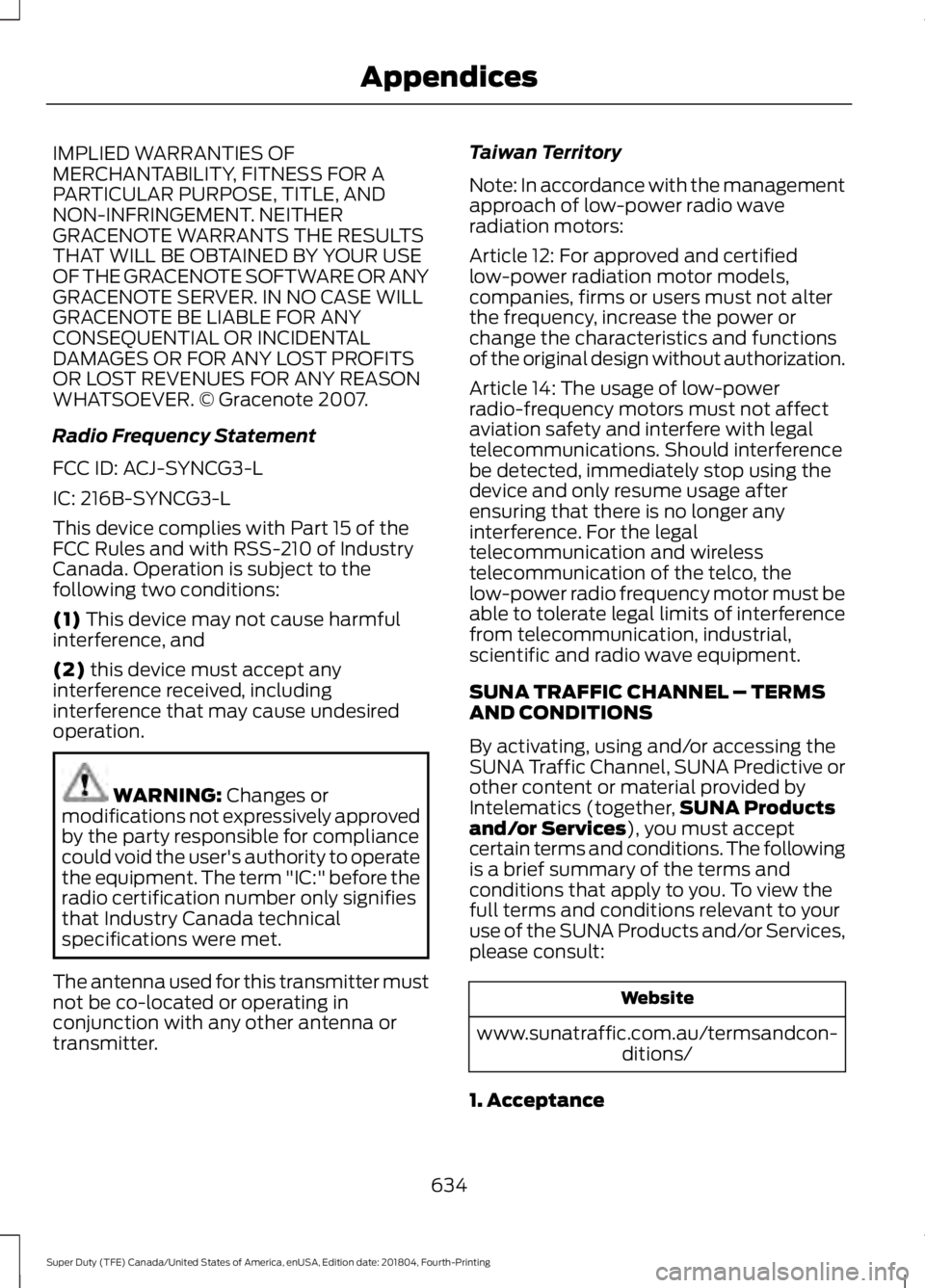
IMPLIED WARRANTIES OF
MERCHANTABILITY, FITNESS FOR A
PARTICULAR PURPOSE, TITLE, AND
NON-INFRINGEMENT. NEITHER
GRACENOTE WARRANTS THE RESULTS
THAT WILL BE OBTAINED BY YOUR USE
OF THE GRACENOTE SOFTWARE OR ANY
GRACENOTE SERVER. IN NO CASE WILL
GRACENOTE BE LIABLE FOR ANY
CONSEQUENTIAL OR INCIDENTAL
DAMAGES OR FOR ANY LOST PROFITS
OR LOST REVENUES FOR ANY REASON
WHATSOEVER. © Gracenote 2007.
Radio Frequency Statement
FCC ID: ACJ-SYNCG3-L
IC: 216B-SYNCG3-L
This device complies with Part 15 of the
FCC Rules and with RSS-210 of Industry
Canada. Operation is subject to the
following two conditions:
(1) This device may not cause harmful
interference, and
(2)
this device must accept any
interference received, including
interference that may cause undesired
operation. WARNING:
Changes or
modifications not expressively approved
by the party responsible for compliance
could void the user's authority to operate
the equipment. The term "IC:" before the
radio certification number only signifies
that Industry Canada technical
specifications were met.
The antenna used for this transmitter must
not be co-located or operating in
conjunction with any other antenna or
transmitter. Taiwan Territory
Note: In accordance with the management
approach of low-power radio wave
radiation motors:
Article 12: For approved and certified
low-power radiation motor models,
companies, firms or users must not alter
the frequency, increase the power or
change the characteristics and functions
of the original design without authorization.
Article 14: The usage of low-power
radio-frequency motors must not affect
aviation safety and interfere with legal
telecommunications. Should interference
be detected, immediately stop using the
device and only resume usage after
ensuring that there is no longer any
interference. For the legal
telecommunication and wireless
telecommunication of the telco, the
low-power radio frequency motor must be
able to tolerate legal limits of interference
from telecommunication, industrial,
scientific and radio wave equipment.
SUNA TRAFFIC CHANNEL – TERMS
AND CONDITIONS
By activating, using and/or accessing the
SUNA Traffic Channel, SUNA Predictive or
other content or material provided by
Intelematics (together,
SUNA Products
and/or Services
), you must accept
certain terms and conditions. The following
is a brief summary of the terms and
conditions that apply to you. To view the
full terms and conditions relevant to your
use of the SUNA Products and/or Services,
please consult: Website
www.sunatraffic.com.au/termsandcon- ditions/
1. Acceptance
634
Super Duty (TFE) Canada/United States of America, enUSA, Edition date: 201804, Fourth-Printing Appendices
Page 663 of 666

Starting and Stopping the Engine..........173
General Information........................................... 173
Steering...........................................................260 Adaptive Learning............................................. 262
Adaptive Steering.............................................. 262
Electronic Variable Overlay Power Steering............................................................. 261
Hydraulic Power Steering............................... 260
Steering Wheel
...............................................84
Storage Compartments.............................170
Sunroof See: Moonroof..................................................... 102
Sun Visors
........................................................101
Illuminated Vanity Mirror................................. 102
Supplementary Restraints System..........47 Principle of Operation......................................... 47
Switching Off the Engine - 6.7L Diesel...............................................................181
Symbols Glossary.............................................8
SYNC™ 3........................................................495 General Information......................................... 495
SYNC™ 3 Troubleshooting......................558
SYNC™ Applications and Services
.......473
911 Assist............................................................... 473
SYNC Mobile Apps............................................ 475
SYNC™............................................................457 General Information.......................................... 457
SYNC™ Troubleshooting
.........................487
T
Tailgate Lock
....................................................74
Tailgate Step....................................................75
Closing the Step.................................................... 76
Opening the Step................................................. 75
Tailgate...............................................................74
Technical Specifications See: Capacities and Specifications.............419
Terrain Control
...............................................231
Principle of Operation....................................... 231
The Better Business Bureau (BBB) Auto Line Program (U.S. Only)........................313
Tire Care
...........................................................381
Glossary of Tire Terminology......................... 382
Information About Uniform Tire Quality Grading.............................................................. 381
Information Contained on the Tire Sidewall........................................................... 383Temperature A B C............................................
382
Traction AA A B C............................................... 381
Treadwear............................................................. 381
Tire Pressure Monitoring System..........398 Trailer Tire Pressure Monitoring
System............................................................. 405
Vehicle Tire Pressure Monitoring System............................................................. 398
Tires See: Wheels and Tires..................................... 379
Towing a Trailer.............................................273 Load Placement................................................. 274
Towing Points
...............................................309
Towing the Vehicle on Four Wheels.........................................................296
Emergency Towing........................................... 296
Recreational Towing........................................ 296
Towing..............................................................273
Traction Control
............................................227
Principle of Operation....................................... 227
Trailer Reversing Aids
..................................275
Principle of Operation...................................... 275
Setting Up Trailer Reverse Guidance..........275
Trailer Reverse Guidance................................. 275
Troubleshooting................................................. 279
Using Trailer Reverse Guidance.................... 278
Trailer Sway Control...................................282
Transfer Case Fluid Check
.......................349
Transmission Code Designation............425
Transmission.................................................206
Transporting the Vehicle
..........................308
Type Approvals............................................636
China...................................................................... 646
Radio Frequency Certification for Keys and Remote Controls.......................................... 646
Radio Frequency Certifications for Blind Spot Information System.......................... 644
Radio Frequency Certifications for Body Control Module............................................. 646
Radio Frequency Certifications for Cruise Control Module............................................. 646
Radio Frequency Certifications for Mid Range Radar................................................... 638
Radio Frequency Certifications for Passive Anti-Theft System....................................... 639
Radio Frequency Certifications for Radio Transceiver Module...................................... 642
660
Super Duty (TFE) Canada/United States of America, enUSA, Edition date: 201804, Fourth-Printing Index
Page 666 of 666
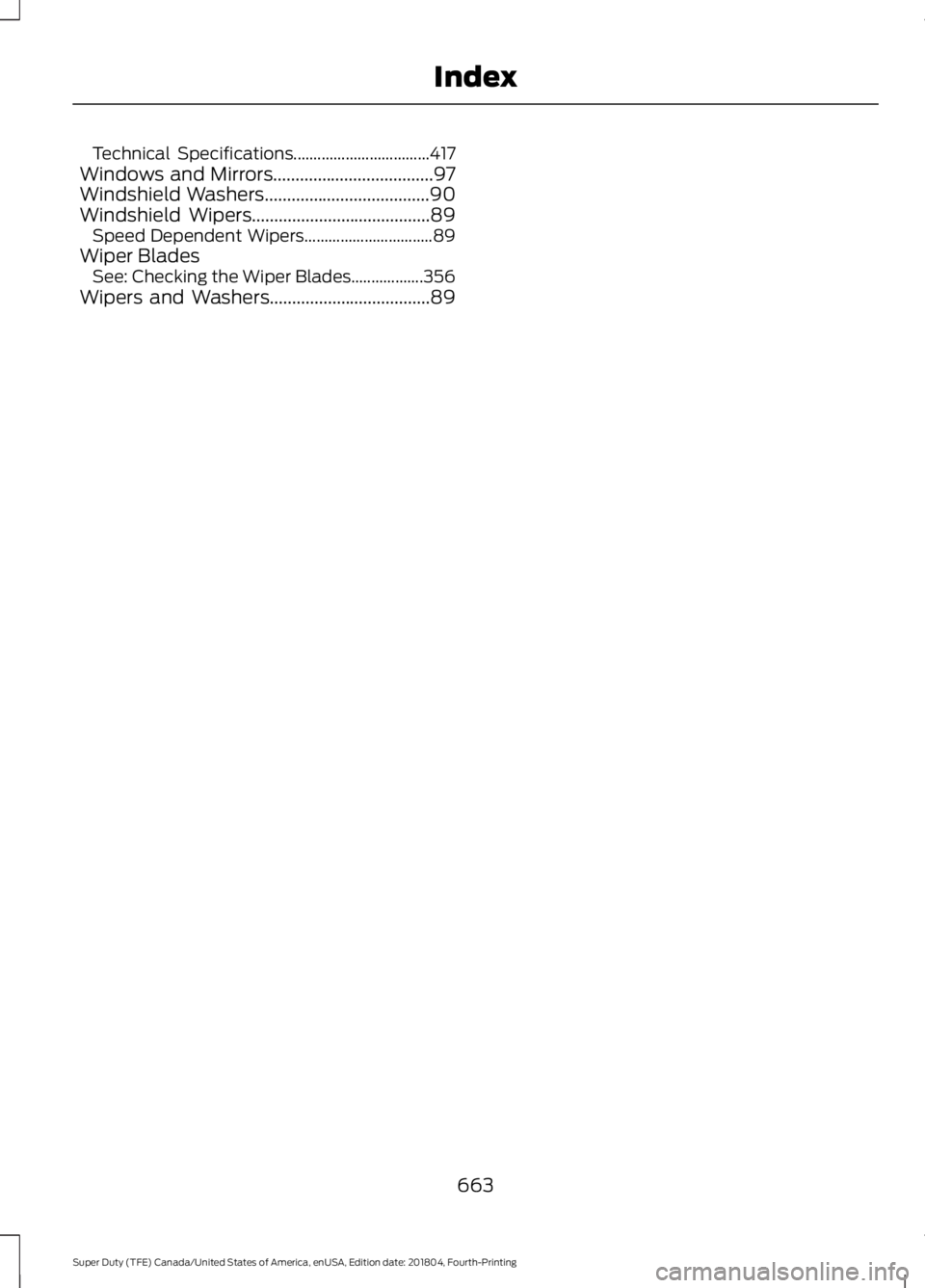
Technical Specifications..................................
417
Windows and Mirrors....................................97
Windshield Washers.....................................90
Windshield Wipers........................................89
Speed Dependent Wipers................................ 89
Wiper Blades See: Checking the Wiper Blades.................. 356
Wipers and Washers....................................89
663
Super Duty (TFE) Canada/United States of America, enUSA, Edition date: 201804, Fourth-Printing Index